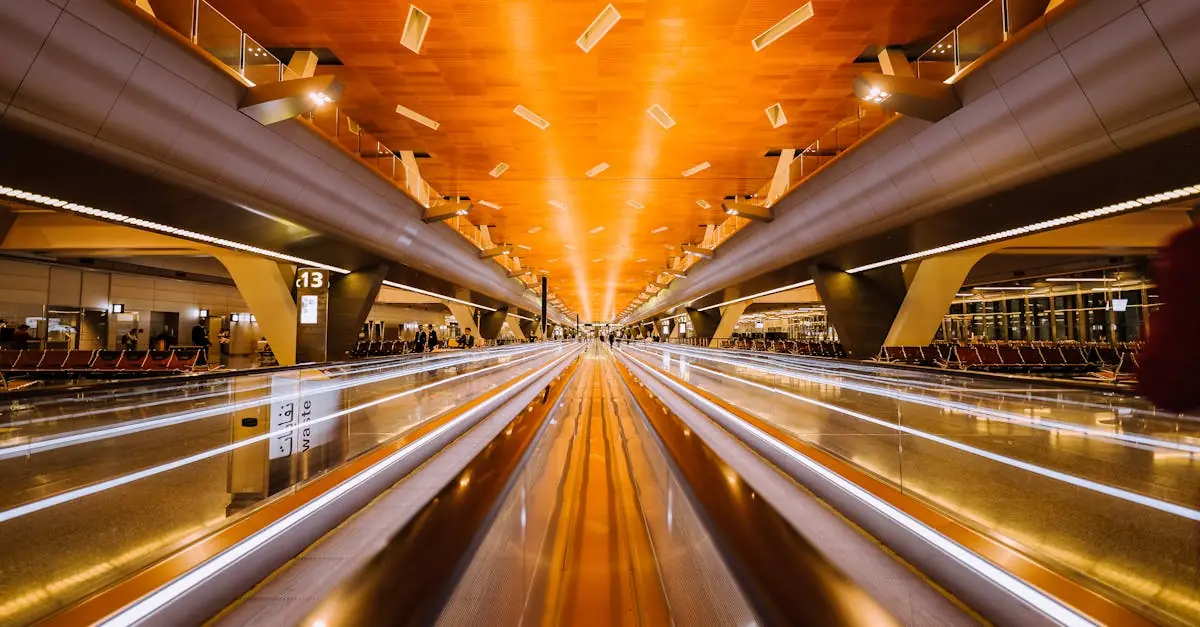Long flights can feel like a marathon, but they don’t have to be a test of endurance. With the right travel tips, he can turn those hours in the air into a comfortable and even enjoyable experience. Imagine gliding through the clouds with snacks in hand, a cozy blanket wrapped around him, and entertainment that makes the time fly—literally!
Table of Contents
TogglePreparing For Your Flight
Preparing for a long flight involves careful planning to maximize comfort. Focus on making the journey more pleasant through effective choices.
Choose The Right Flight
Selecting an optimal flight time can make a significant difference. Early morning flights often provide less turbulence and a smoother experience. Red-eye flights offer the advantage of sleeping during the journey. Non-stop flights eliminate layovers, reducing total travel time. Consider the duration of layovers when booking connecting flights, as shorter layovers can create a more pleasant travel experience.
Packing Essentials
Packing the right items ensures comfort throughout the flight. Include a neck pillow and a lightweight blanket for better sleep. Layered clothing allows adjustment to changing cabin temperatures. Snacks like nuts or granola bars provide much-needed energy and satisfaction. Don’t forget to pack essential toiletries such as wipes and a toothbrush for a refreshing feeling. Finally, electronic devices with pre-downloaded entertainment can make hours fly by.
Comfort During The Flight
Comfort plays a crucial role in making long flights more enjoyable. By focusing on your attire and packing the right accessories, you can significantly enhance your experience.
Dress Comfortably
Choosing the right clothing for a long flight promotes comfort. Opt for loose-fitting clothes made of breathable fabrics. Comfortable footwear allows for easier movement through the cabin. Layering clothing helps adapt to shifting temperatures on the plane. Avoid tight garments that restrict movement and can cause discomfort during extended sitting periods. Prioritizing comfort in attire contributes directly to a positive travel experience.
Use Travel Accessories
Incorporating travel accessories can make a noticeable difference in comfort levels. Neck pillows provide essential support for the head and neck, reducing strain during sleep. Eye masks block out light, creating a more conducive environment for rest. Noise-canceling headphones drown out cabin noise, allowing for immersive entertainment or relaxation. Packing a lightweight blanket offers added warmth during chilly flights. All these accessories serve to enhance overall comfort while flying long distances.
Entertainment Options
Long flights become more enjoyable with the right entertainment choices. Passengers should consider options that keep them engaged throughout the journey.
Download Movies and Shows
Downloading movies and shows ahead of time prevents reliance on in-flight options that may not appeal. Travelers can utilize streaming services to access content offline, ensuring hours of entertainment. Critical is selecting a mix of genres to suit different moods. Action thrillers, comedies, and documentaries provide variety and keep boredom at bay. Allocating several hours for downloading before the trip is essential since in-flight internet can be unreliable.
Bring Books or E-Readers
Bringing books or e-readers enables passengers to dive into different worlds during a flight. Physical books and e-readers both have their advantages, offering flexibility in reading preferences. E-readers, particularly, can store multiple titles, saving valuable luggage space. Consider choosing a mix of fiction and non-fiction to satisfy various interests. Setting a reading goal can further enhance the experience, motivating travelers to immerse themselves in captivating narratives.
Staying Healthy
Maintaining health during long flights is essential. Following a few strategies can greatly enhance comfort and well-being.
Stay Hydrated
Drinking plenty of water is crucial while flying. Cabin air is often dry, leading to dehydration. Aim for at least 8 ounces of water every couple of hours. Avoid excessive caffeine and alcohol, as they can contribute to dehydration. Bring a reusable water bottle to keep hydration accessible. Prioritize hydrating foods like fruits and vegetables that can supplement fluid intake. If possible, request water from the flight attendants regularly. Staying hydrated helps combat fatigue and enhances overall comfort.
Move Around Regularly
Movement during a flight can reduce the risk of stiffness and blood clots. Aim to stand up and walk every hour. Stretching in the seating area also creates relief. Simple exercises like ankle circles and leg extensions can increase circulation. Use the time spent waiting for the restroom as an opportunity to stretch. Engage in light movement, even a brief walk down the aisle. Frequent movement enhances comfort and promotes better blood flow throughout the flight.
Managing Jet Lag
Managing jet lag becomes essential when embarking on long flights. Travelers can alleviate its effects by following effective strategies that promote adjustment to new time zones.
Adjust Your Sleep Schedule
Adjusting the sleep schedule before departure aids in reducing jet lag symptoms. Shifting bedtime by one hour several days prior to flying can help the body acclimate. Travelers can also utilize apps that help determine optimal sleep and wake times. Exposure to natural light upon arrival supports circadian rhythm adjustment. If possible, catering sleeping patterns to match the destination time helps minimize disruption. Staying awake during the flight may also be necessary if arriving early in the morning at the destination, enhancing the body’s adaptation to the new schedule.
Stay Active Upon Arrival
Staying active upon arrival plays a significant role in combating jet lag. Engaging in light exercise, such as walking or stretching, can boost energy levels. Choosing to explore the surroundings upon arrival helps keep the mind engaged. Deciding to avoid long naps during the day can also help in adjusting to local time quicker. Travelers can benefit from scheduling outdoor activities to take advantage of daylight, which aids in regulating sleep patterns. Hydration remains essential too, as drinking water facilitates recovery and helps restore the body after a long flight.
Traveling long distances doesn’t have to be a daunting experience. With thoughtful preparation and the right strategies in place, travelers can transform their flights into enjoyable journeys. Prioritizing comfort through clothing choices and travel accessories can make a significant difference.
Staying entertained with pre-downloaded content and engaging books helps pass the time effectively. Maintaining hydration and incorporating movement during the flight supports overall health and well-being.
Lastly, managing jet lag through gradual adjustments and hydration ensures a smoother transition upon arrival. By implementing these tips, long flights can become not just bearable but truly enjoyable adventures.




